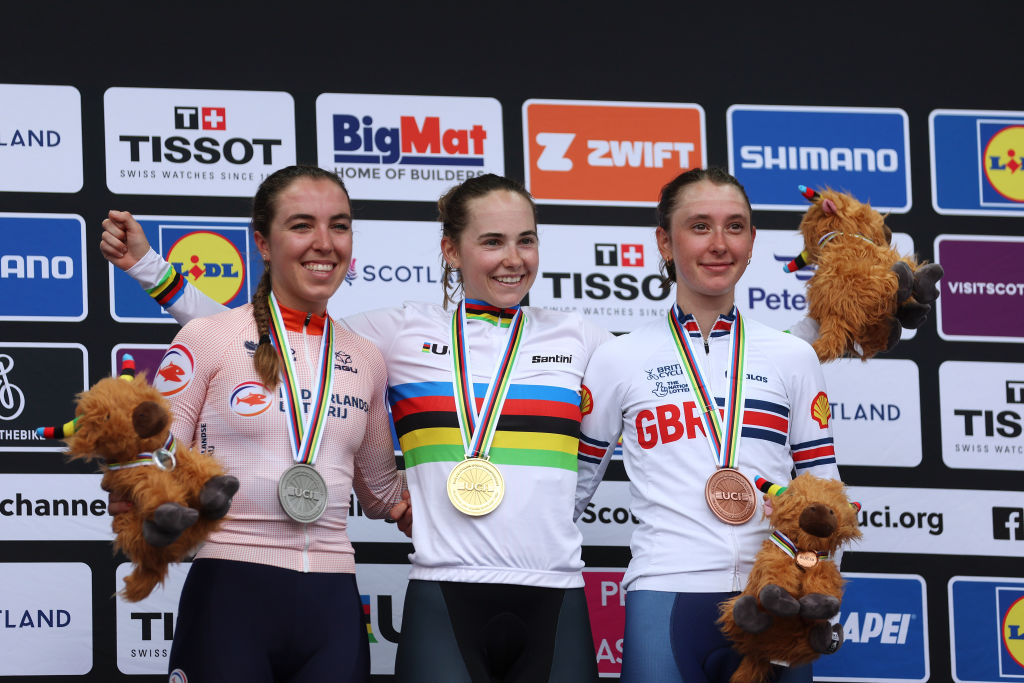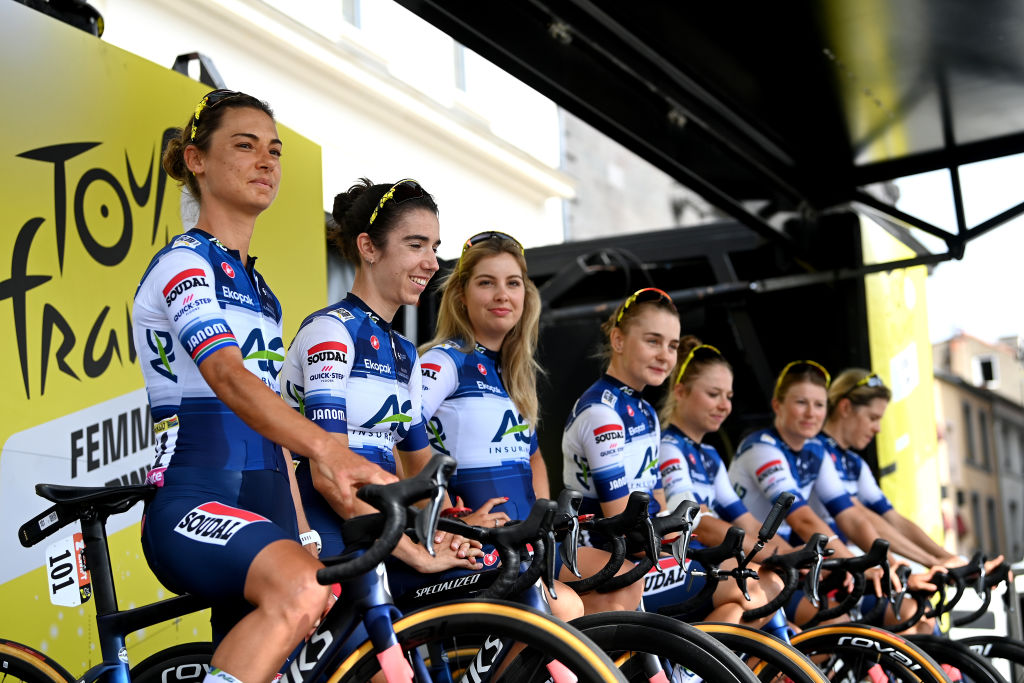
The first-ever Tour de l’Avenir Femmes takes place over the next few days. The best young talent in the women’s peloton have a prized opportunity to compete against their peers, hoping to prove themselves as the next stars of the sport.
It’s one of just a couple of opportunities that this group of riders will get to compete against each other this year. The other major event is the European Championships, which has had an under-23 women’s race since 1995, very much the outlier in women’s road cycling. The World Championships only recognised the under-23 women’s category for the first time in 2022, but this was as part of the elite women’s road race.
Compare that to the men’s under-23 category, which has a multitude of long-standing, high-level under-23-only races. These races are the backbone of talent development in men’s cycling – stars are born, mistakes are made, and lessons are learned. It’s an invaluable period of growth for most young bike racers.
But in the women’s peloton, most of the best junior riders have to jump straight up into the WorldTour. There is no prescribed development period in between.
Blanka Vas wins race within a race to take women's U23 World Championships title
AG Insurance-NXTG build three-tier women's development programme in 2023
A winner with no race – The enigmatic new women's U23 category at the World Championships
It's time for a U23 women's category at the UCI Road World Championships
“It's just a bit of a shock coming from junior level and going straight into the elites,” Anna Shackley of SD Worx told Cyclingnews a few days out from racing the Tour de l’Avenir Femmes, only her second-ever under-23 race.
“They're like small fish in a really, really big pond. It's hard when you come from such a young age into those huge races. You're going from winning as a junior to struggling to finish the next year, which is pretty hard mentally."
For most, there are no steady steps of development. Unfortunately, many riders who showed promise as juniors leave the sport in their early twenties. They are forced to either sink or swim.
In 2021, the USA’s Kaia Schmid finished second in the junior women’s road race at the World Championships in Leuven. It was only Schmid’s second race in Europe. Her breakthrough result secured her a place in the World Tour for the next season with Human Powered Health.
The two seasons that followed have been difficult for the now 20-year-old. She has battled with illness and injury, most recently a knee problem after a crash at the Ronde de Mouscron, which kept her out of race action for three months.
The step from the junior ranks to the WorldTour has also been mentally difficult for Schmid due to the transition from winning races to merely fighting for survival.
“I haven't been on a podium in two years now, so the confidence goes away a little bit,” Schmid told Cyclingnews. “When you step up and you keep repeatedly thinking, ‘Oh, how am I going to finish the race today?’ Or you’re fighting for 50th place in these classic races, you lose a bit of that confidence.”
Schmid thinks that more lower-level racing would aid the development of riders like her.
“Having those lower level races allows you to keep that confidence and it helps you to learn how to win a race… I did learn so much in the past two years from my teammates, working for them and seeing what it's like and how a World Tour team works, but I think having that development aspect would have been really important."

It’s a sentiment shared by Natascha den Ouden, Team Manager of AG Insurance-Soudal-QuickStep as well as the only UCI registered women’s under-23 squad, AG Insurance-NXTG U23.
Den Ouden sees the value in young riders having the space to mature in a smaller environment, to develop their skills as riders, but also to grow as people. She thinks that, for most riders, jumping straight into a World Tour team is not the right environment for them to develop.
“When they are going straight to the World Tour, they don't compete, they try to finish,” Den Ouden told Cyclingnews. “That's not part of development. You need to learn to ride as a team, to explore tactics, to make mistakes – making mistakes makes you develop.”
“Some riders from 18 or 19 years old really need more time to be stronger to compete better, and to develop themselves also as a person.”
Along with the development of under-23 racing, Den Ouden thinks that a ban on World Tour teams being able to race low-level UCI races (as exists in men’s cycling) would enable talented youngsters to grow as it would allow them to compete against others of a similar level. Most UCI .2 level races are dominated by World Tour teams.
“I hope that in the near future, the UCI decides to close 1.2 and 2.2 races to the World Tour, so smaller teams can put their riders in and more riders can put their nose to the window to show themselves, because there's really a big bunch of talent coming up now, but they have to get the chance. That’s why it's so important that more and more World Tour teams have a specific under-23 team. It's a stepping stone.”

When asked by Cyclingnews about the future development of women’s under-23 racing, the UCI said that they are “fully aware that the creation of dedicated races for the Women under-23 category is ultimately the way forward for the continued progression of women's cycling.”
The UCI statement continued: “Introducing two separate podium ceremonies for Women Elite and Women Under 23 at the UCI Road World Championships in Wollongong, Australia, last year – repeated in Scotland earlier this month – was already a step in this direction. The organisation of separate events for athletes in the Women Under 23 category is currently being studied, and is already planned for the programme of the 2025 UCI Road World Championships in Kigali, Rwanda. The introduction of dedicated Women Under 23 races (in addition to Tour de l’Avenir Femmes) is a gradual process that must be carried out in collaboration with teams and organisers as it requires reflection from a point of view of logistics (financial and operational) and planning of the UCI International Calendar.”
Progress is steadily on its way. The next step in that process will begin in Saint-Vallier at the start of the inaugural Tour de l’Avenir Femmes. Schmid is excited at the prospect of joining her American teammates and having a rare opportunity to show her talent.
“It's definitely extra motivation,” Schmid said. “It's the first age-group race that I've raced since junior Worlds in Leuven…a lot of work has been done since I joined Human Powered Health, it would be nice to hopefully get an opportunity at l'Avenir for sure.”
There aren’t many races on the global cycling calendar that really need to exist quite as much as the Tour de l’Avenir Femmes. It’s the next building block for the creation of a proper development system within women’s cycling.
For some riders, the next few days will be the start of their next chapter, a step to something greater.
Hopefully, the same is true for women’s cycling.







